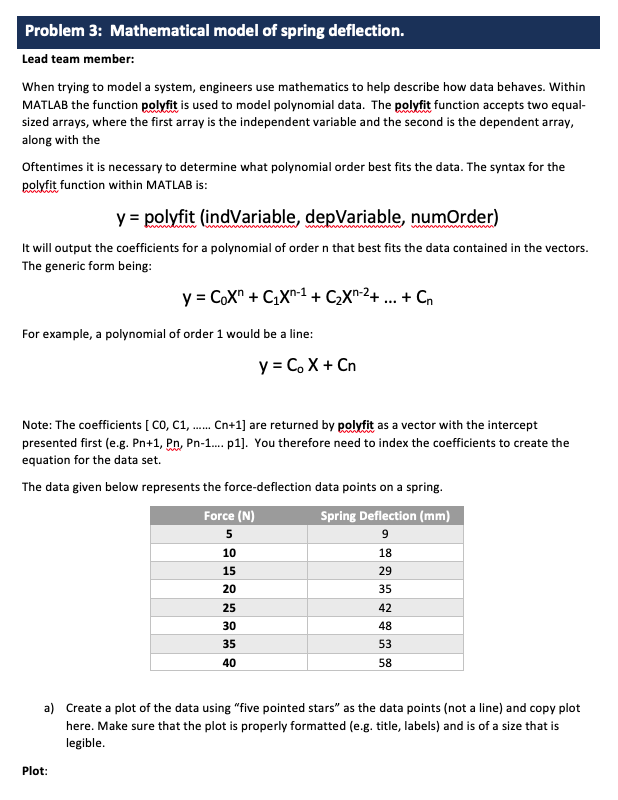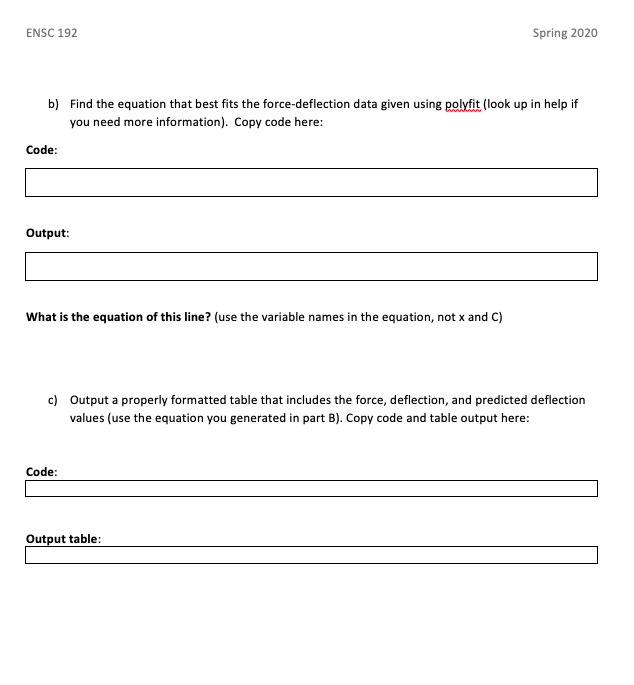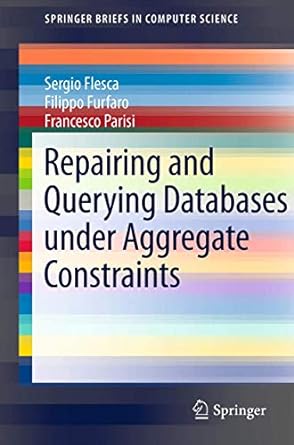

Problem 3: Mathematical model of spring deflection. Lead team member: When trying to model a system, engineers use mathematics to help describe how data behaves. Within MATLAB the function polyfit is used to model polynomial data. The polyfit function accepts two equal- sized arrays, where the first array is the independent variable and the second is the dependent array, along with the Oftentimes it is necessary to determine what polynomial order best fits the data. The syntax for the polyfit function within MATLAB is: y = polyfit (indVariable, depVariable, numorder) It will output the coefficients for a polynomial of order n that best fits the data contained in the vectors. The generic form being: y = Cox" +Cjxn-1 + Czxn-2+ ... + Cn For example, a polynomial of order 1 would be a line: y = C. X + Cn Note: The coefficients [CO, C1, ...... Cn+1] are returned by polyfit as a vector with the intercept presented first (e.g. Pn+1, Pn, Pn-1.... p1]. You therefore need to index the coefficients to create the equation for the data set. The data given below represents the force-deflection data points on a spring. Force (N) Spring Deflection (mm) 10 18 58 a) Create a plot of the data using "five pointed stars" as the data points (not a line) and copy plot here. Make sure that the plot is properly formatted (e.g. title, labels) and is of a size that is legible. Plot: ENSC 192 Spring 2020 b) Find the equation that best fits the force-deflection data given using polyfit (look up in help if you need more information). Copy code here: Code: Output: What is the equation of this line? (use the variable names in the equation, not x and C) c) Output a properly formatted table that includes the force, deflection, and predicted deflection values (use the equation you generated in part B). Copy code and table output here: Code: Output table: Problem 3: Mathematical model of spring deflection. Lead team member: When trying to model a system, engineers use mathematics to help describe how data behaves. Within MATLAB the function polyfit is used to model polynomial data. The polyfit function accepts two equal- sized arrays, where the first array is the independent variable and the second is the dependent array, along with the Oftentimes it is necessary to determine what polynomial order best fits the data. The syntax for the polyfit function within MATLAB is: y = polyfit (indVariable, depVariable, numorder) It will output the coefficients for a polynomial of order n that best fits the data contained in the vectors. The generic form being: y = Cox" +Cjxn-1 + Czxn-2+ ... + Cn For example, a polynomial of order 1 would be a line: y = C. X + Cn Note: The coefficients [CO, C1, ...... Cn+1] are returned by polyfit as a vector with the intercept presented first (e.g. Pn+1, Pn, Pn-1.... p1]. You therefore need to index the coefficients to create the equation for the data set. The data given below represents the force-deflection data points on a spring. Force (N) Spring Deflection (mm) 10 18 58 a) Create a plot of the data using "five pointed stars" as the data points (not a line) and copy plot here. Make sure that the plot is properly formatted (e.g. title, labels) and is of a size that is legible. Plot: ENSC 192 Spring 2020 b) Find the equation that best fits the force-deflection data given using polyfit (look up in help if you need more information). Copy code here: Code: Output: What is the equation of this line? (use the variable names in the equation, not x and C) c) Output a properly formatted table that includes the force, deflection, and predicted deflection values (use the equation you generated in part B). Copy code and table output here: Code: Output table








